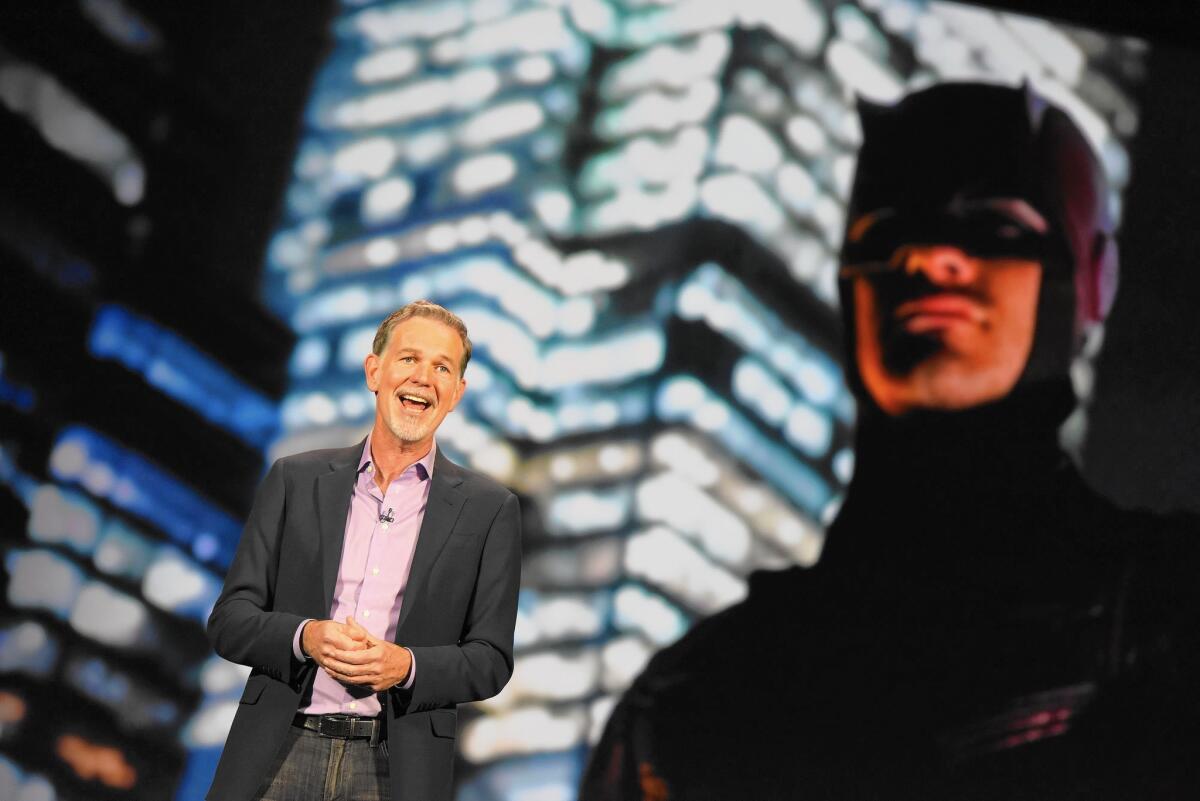Netflix: The most feared force in Hollywood?

- Share via
Time Warner Chief Executive Jeff Bewkes once likened Netflix to the “Albanian army.”
That army now has more than 70 million subscribers in nearly 200 countries — and may well be the most feared force in Hollywood.
The Los Gatos, Calif., company has moved from its foundation as a video rental business to become an entertainment juggernaut generating award-winning content for both its digital streaming service and theatrical releases. Many of Hollywood’s most talented writers and producers take their proposals to Netflix first.
SIGN UP for the free Gold Standard newsletter >>
It’s also a Wall Street favorite valued at nearly $45 billion, giving Netflix financial firepower to go with its impressive subscriber base.
“Every single day in my company, and I know in other companies, there’s a question of: ‘Did we do something ... to build a monster that will come back to kill us?’” NBCUniversal research President Alan Wurtzel said last week at the Television Critics Assn. media tour in Pasadena.
The tipping point came last summer when Walt Disney Co. revised profit expectations for its cable channels including ESPN, reflecting an industrywide shift as more consumers cut their cable offerings in favor of Netflix or other services. The news triggered a sell-off of media stocks, erasing nearly $50 billion in market value in two days.
Media stocks have not recovered, and executives such as Bewkes have signaled a possible change in their dealings with Netflix and other digital outlets. He said Time Warner was considering holding onto episodes of its shows longer before making them available for video-on-demand services.
“Media companies are saying: ‘We are cutting our own throats here, and we’re bleeding,’” said Doug Creutz, media analyst with Cowen & Co.
Hollywood long has had a love-hate relationship with Netflix. The honeymoon began when Netflix was just a scrappy vendor that would buy DVDs of movie and TV shows and send them in red envelopes to customers across the country (which it still does). The business generated revenue for the studios through increased DVD sales. Then, in 2007, Netflix added a streaming option and provided studios with even more money for the rights to their old movies and TV reruns.
But tensions have escalated as Netflix has become the go-to destination for millions of viewers who are attracted by its low cost — $9.99 a month — ease of use and commercial-free programming.
“Netflix has been built on the back of great content from studios like our own,” Fox Television Group Co-Chairman Dana Walden said in an interview at the Television Critics Assn. media tour. “It has helped to reinvigorate fan bases of shows. But from the network side, it’s very challenging. They’re a competitor.”
Last year, Netflix Chief Executive Reed Hastings ribbed the traditional TV networks, likening them to a fax machine — amazing in the 1980s but now outdated. At the CES technology conference this month in Las Vegas, Hastings told attendees they were “witnessing the birth of a new global Internet TV network.”
At a pre-Golden Globes party at Ted Sarandos’ home in Hancock Park the following night, Netflix’s head of content was still reveling in the achievement.
“Everywhere in the world, your shows are on Netflix and people are enjoying them right now,” Sarandos told the crowd that included comedians Chelsea Handler and Aziz Ansari and the cast of “Orange Is the New Black.” A few partygoers whooped and cheered.
Netflix has been ramping up production of shows that will be exclusive to the service. It plans to make 600 hours of original programming in fiscal 2016.
That puts it on par with what a broadcast TV network airs in prime time. Netflix’s slate includes new seasons of “House of Cards” and “Grace and Frankie” and the debut of “Fuller House,” a remake of a hit 1980s sitcom.
Netflix also has been rattling the movie theater industry by streaming its own original films on the same day they arrive in cinemas. Fearing a threat to their industry, some cinema chains have refused to distribute Netflix films, including its acclaimed “Beasts of No Nation” and the sequel to “Crouching Tiger, Hidden Dragon,” which will premiere next month on Netflix and at select Imax theaters.
Once a footnote at the Television Critics Assn. media tour, where TV networks showcase their upcoming series, Netflix on Sunday presented 14 panels with an all-star lineup of some of its most popular shows. Just outside the main room where Sarandos spoke, a replica of the “House of Cards” oval office was on display, along with exhibits of costumes for shows such as “Jessica Jones” and “Unbreakable Kimmy Schmidt.”
See more of Entertainment’s top stories on Facebook >>
One potential obstacle to Netflix’s global ambitions, however, is that many studios refuse to hand over international rights for the TV shows they sell to Netflix. The studios want to hold onto those lucrative rights for themselves as they expand their own operations in other countries.
“Every year the exclusions of different countries in our licensing agreements become less and less,” Sarandos said at the TV critics media tour. “Our ultimate goal is that Netflix is basically the same everywhere in the world. That being said, there are existing output deals that tie up some of the content for years.”
Media executives view Netflix with a mix of admiration and fear. The concern is Netflix has been instrumental in encouraging consumers to drop their pay-TV subscriptions in favor of a streaming service. In consumer satisfaction surveys, Netflix wins high marks in contrast to cable TV companies, which have a reputation for poor customer service.
“It started out with Netflix wanting admission to the party. Then they got in and mingled well with the TV guys,” said FBR Capital Markets analyst Barton Crockett. “But now they’ve become so strong and the life of the party that now those TV guys are wondering if maybe they liked Netflix too much, too soon.”
TV networks must fight with Netflix for premier projects, and in many cases producers are attracted by Netflix’s talent-friendly culture that allows them to take more creative risks because Netflix is not beholden to ratings or advertisers.
Netflix also ushered in an era of binge-viewing that has helped train viewers to opt for on-demand commercial-free programming. That culture threatens another pillar of media: advertising revenue. TV companies receive about $70 billion a year in ad revenue, according to Kantar Media.
Media companies have responded to Netflix’s incursion and the changes in consumer behavior by launching their own streaming services. NBCUniversal unveiled a comedy outlet called SeeSo, CBS has CBS All Access, and premium channels Showtime and HBO have direct-to-consumer offerings.
Studios also are selling more shows to Amazon.com and building Hulu into a more vibrant competitor to Netflix (Hulu is owned by Disney, NBCUniversal and 21st Century Fox). Hulu last year nabbed streaming rights to the entire “Seinfeld” library, as well as licensing deals with AMC, Discovery, Turner Broadcasting and FX Networks. Epix began steering its movies to Hulu last summer when its pact with Netflix expired.
“Studios and networks are clearly interested in seeing other players balance out the strength of Netflix,” Crockett said.
Netflix, Sarandos said, appreciates the business challenges that traditional media companies face.
“There’s a lot of chaos in the media space,” Sarandos told The Times. “The emergence of subscription video-on-demand, and what it means to linear television and the value of cable channels — all that stuff — it’s all very complicated for them and they’re trying to manage.”
In fact, media companies have made hundreds of millions of dollars by selling their shows to Netflix, including old product from their libraries whose shelf life on TV had long passed. Netflix also has become a hungry buyer of new originals, and has ordered such shows from traditional studios — including Warner Bros., which produces three originals for Netflix. Disney produces Marvel shows for Netflix, including “Jessica Jones” and “Daredevil,” and Sony Pictures Television has two projects in the works.
The small CW television network, owned by CBS and Warner Bros., lost money for years until 2011 when it struck a four-year, $1-billion deal to provide its programming, including “Jane the Virgin” and “Arrow,” to Netflix. The network finally turned a profit. On Friday, Fox announced that it was reviving its canceled drama “Prison Break” because audiences were devouring old episodes on Netflix.
“Netflix is a great revenue source for them, and they’re trying to figure out how do they make sure this revenue source doesn’t undermine their long-term economic health,” Sarandos said. “They’re just trying to navigate those waters.”
Many point to the “Breaking Bad” effect to illustrate how Netflix can be friend and foe. The AMC drama, about a chemistry teacher-turned-meth dealer, was a middling performer for the cable channel until its fourth season, when many viewers discovered it on Netflix. The show’s audience steadily grew, and by its fifth and final season had shot up in the ratings. Still, some viewers waited to see the episodes on Netflix and they associated “Breaking Bad” with Netflix — not AMC.
Some TV executives believe the Netflix threat might be overblown.
“The reports of our death have been greatly exaggerated,” NBCUniversal’s Wurtzel said.
Wurtzel cited research from independent firm Symphony Advanced Media that showed that although Netflix makes a pop with its original shows, viewers might binge on episodes for a few days, or even a few weeks, but then return to traditional viewing patterns. Viewers watch an average of 5.43 hours per day of programming, according to Nielsen data, and about 28 minutes of viewing is through services such as Netflix and Hulu.
In contrast, viewers spend more than four hours a day watching broadcast and cable TV.
“People are watching TV the way God intended,” Wurtzel said.
ALSO
‘Fuller House’ producers address that Olsen Twins joke
Box office: Kevin Hart and Ice Cube’s ‘Ride Along 2’ unseats ‘Star Wars’
It’s still ‘Netflix and no ratings’ -- Ted Sarandos rejects a numbers ‘arms race’
More to Read
The biggest entertainment stories
Get our big stories about Hollywood, film, television, music, arts, culture and more right in your inbox as soon as they publish.
You may occasionally receive promotional content from the Los Angeles Times.












